1993 BUICK CENTURY power steering
[x] Cancel search: power steeringPage 75 of 324
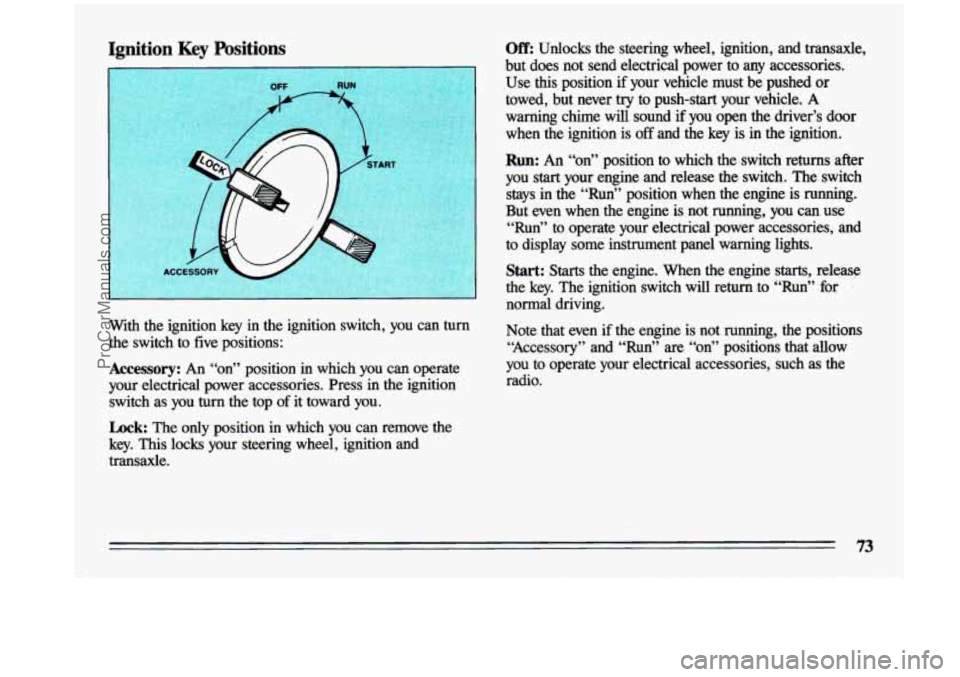
Ignition Key Positions Off: Unlocks the steering wheel, ignition, and transaxle,
but does not send electrical power to any accessories.
.Use
this position if your vehicle must be pushed or
towed, but never try to push-start your vehicle.
A
warning chime will sound if you open the driver’s door
when the ignition
is off and the key is in the ignition.
I
Run: An “on” position to which the. switch returns after
you
start your engine and release the switch. The switch
stays in the “Run” position when the engine is running.
But even when the engine is not running, you can use
“Run” to operate your electrical power accessories, and
to display some instrument panel warning lights.
Start: Starts the engine. When the engine starts, release
the key. The ignition switch will return to “Run” for
normal driving.
with the ignition key
h the ignition switch, YOU can turn Note that even if the engine is not running, the positions
the switch to five positions: “Accessory” and “Run” \
are “on” positions that allow
.Accessory: An “on” position in which you can operate you to operate your electrical accessories, such as the
your electrical power accessories. Press
in the ignition ‘ radio.
switch as you
turn the top of it toward you.
Lock: The only position in which you can remove the
key. This locks your steering wheel, ignition
and
transaxle.
ProCarManuals.com
Page 152 of 324
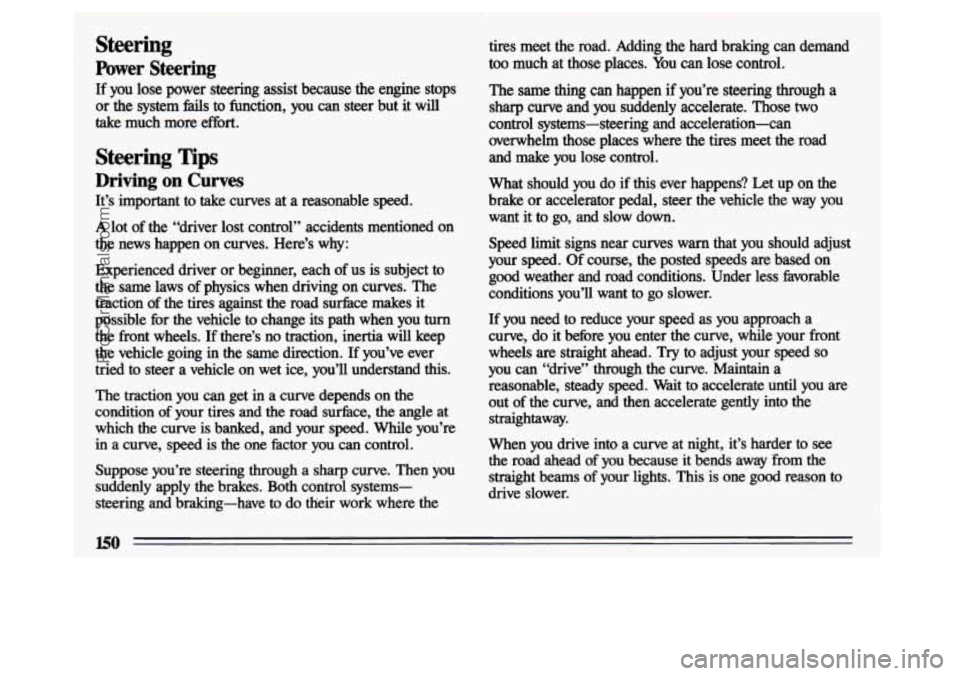
Steering
Power Steering
If you lose power steering assist because the engine stops
or the system
fails to function, you can steer but it will
take much more effort.
Steering Tips
Driving on Curves
It’s important to take curves at a reasonable speed.
A lot of the “driver lost control” accidents mentioned on
the news happen on curves. Here’s why:
Experienced driver or beginner, each of us is subject to
the same laws of physics when driving on curves. The
traction
of the tires against the road surface makes it
possible for the vehicle to change its path when you turn
the front wheels. If there’s no traction, inertia will keep
the vehicle going
in the same direction. If you’ve ever
tried to steer a vehicle on wet ice, you’ll understand
this.
The traction you can get in a curve depends on the
condition
of your tires and the road surhce, the angle at
which the curve is banked, and your
speed. While you’re
in a curve, speed is the one factor you can control.
Suppose you’re steering through
a sharp curve. Then you
suddenly apply
the brakes. Both control systems-
steering and braking-have
to do their work where the
tires meet the road. Adding the hard braking can demand
too much at those places. You can lose control.
The
same thing can happen if you’re steering through a’
sharp curve and you suddenly accelerate. Those two
control systems-steering and acceleration-can
overwhelm those places where the tires meet the road and make you lose ‘control.
What should you do
if this ever happens? Let up on the
brake or accelerator
pedal, steer the vehicle the way you
want it to go, and slow down.
Speed limit signs near curves warn that you should adjust
your
speed. Of course, the posted speeds are based on
good weather and road conditions. Under less favorable
conditions you’ll want
to go slower.
If you need to reduce your speed as you approach a
curve, do it before you enter the curve, while your front
wheels
are straight ahead. Try to adjust your speed so
you can “drive” through the curve. Maintain a
reasonable, steady speed. Wait to accelerate until you are
out of the curve, and then accelerate gently into the
straightaway.
When you drive
into a curve at night, it’s harder to see
the road ahead of you because it bends away .from the
straight beams of your lights.
This is one good reason to
drive slower.
ProCarManuals.com
Page 223 of 324

.
n
Part 6 Service and Appearance Care
. .
Here you will find information about the care of your Buick . This part begins with service and fuel information.
and then
it shows how to check important fluid and lubricant levels . There is also technical information about
your vehicle. and a section devoted to
its appearance care .
Part 6 includes:
Service ........................................................................\
..... 222
Fuel ........................................................................\
...... 223
HoodRelease ....................................................................... \
226
Engine Oil ........................................................................\
. 227
Aircleaner ........................................................................\
2.3
TransaxleFluid ..................................................................... 236
Enginecoolant ..................................................................... 239
Power Steering Fluid ................................................................. 241
Windshield Washer Fluid .............................................................. 242
Brakes ........................................................................\
.... 243
Battery ........................................................................\
.... 244
BulbReplacement ................................................................... 245
Tires ........................................................................\
...... 251
Loadingyourvehicle ................................................................. 249
Appearancecare .................................................................... 258
Vehicle Identification Number (VIN), Add-on Electrical Equipment ............................ 265
Capacities and Specifications .......................................................... -270
Fuses&CircuitBreakers .............................................................. 266
ReplacementBulbs .................................................................... 269
ProCarManuals.com
Page 243 of 324

Radiator Pressure Cap
ur radiator cap is a 15 psi (105 kPa)
When you replace your radiator pressure cap, an AC@
cap is recommended.
Thermostat
Engine coolant temperature is controlled by a thermostat
in the engine coolant system. The thermostat stops the
flow of coolant through the radiator until the coolant
reaches a preset temperature.
When you replace
your thermostat, an AC@ thermostat is
recommended.
Power Steering Fluid
mp ”-- How to Check Power
Steering Fluid:
I Unscrew the cap and wipe
the dipstick with a clean f rag. Replace the cap and
completely tighten it. Then
remove the cap again and
look at the fluid level on the
dipstick. .1,. ,,
When me engine compartment is hot, the level should
When the engine compartment is cool, the level should
be at the “H” (Hot) mark.
be at the “C” (Cold) mark.
What to Add:
Refer to the Maintenance Schedule to determine what
kind
of fluid to use. See “Recommended Fluids and
Lubricants” in the Index.
241
ProCarManuals.com
Page 244 of 324

When adding power steering fluid or making a
complete fluid change, always use the proper
fluid. Failure to use the proper fluid can cause
leaks and damage hoses and seals.
,- . ,.
Windshield Washer Fluid
To Add:
The windshield washer reservoir is located at the driver’s
side
of the engine compartment. The rear window washer fluid reservoir (for the wagon)
is the smaller
reservoir next
to the coolant recovery tank.
Open the cap labeled “WASHER FLUID ONLY? Add
washer fluid until the bottle
is full.
ProCarManuals.com
Page 273 of 324
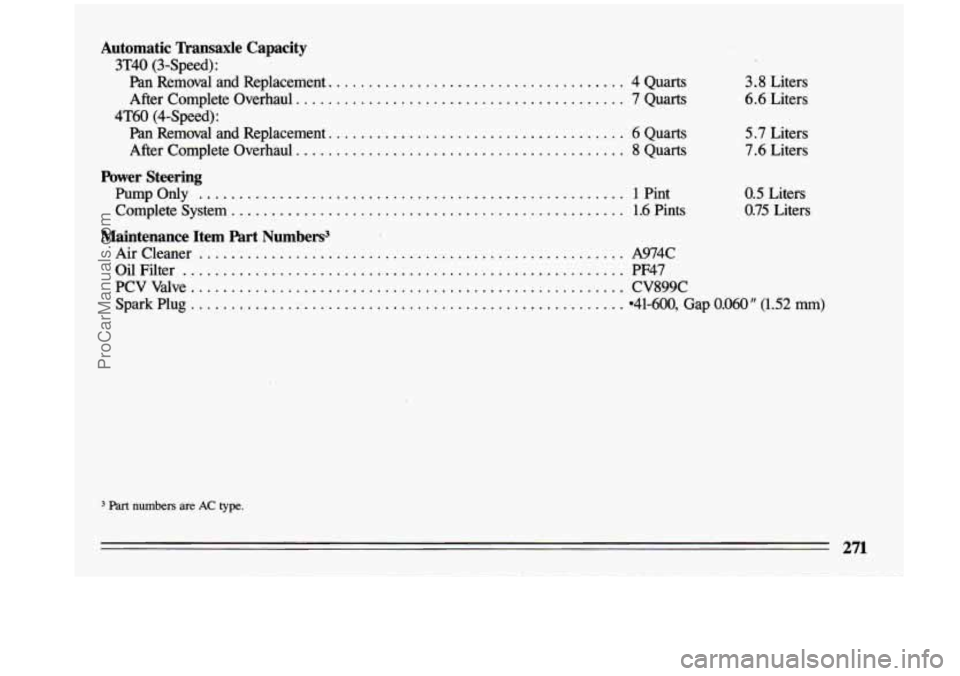
Automatic Tkansaxle Capacity
3T40 (3-Speed) :
Pan Removal and Replacement. ....................................
After Complete Overhaul. ........................................
Pan Removal and Replacement. ....................................
After Complete Overhaul. ........................................
4T60 (4-Speed):
Power Steering
PumpOnly .....................................................
Complete System. ................................................
Maintenance Item part Numbers3
Air Cleaner
Oil Filter
. .
PCV Valve .
Spark Plug .
.....................................................
.....................................................
.....................................................
.....................................................
4 Quarts
7 Quarts
6 Quarts
8 Quarts
1 Pint
1.6 Pints
3.8 Liters
6.6 Liters
5.7 Liters
7.6 Liters
0.5 Liters
0.75 Liters
M4C PF47
CV899C
041-600, Gap
0.060 It (1.52 m)
Part numbers are AC type.
271
ProCarManuals.com
Page 275 of 324
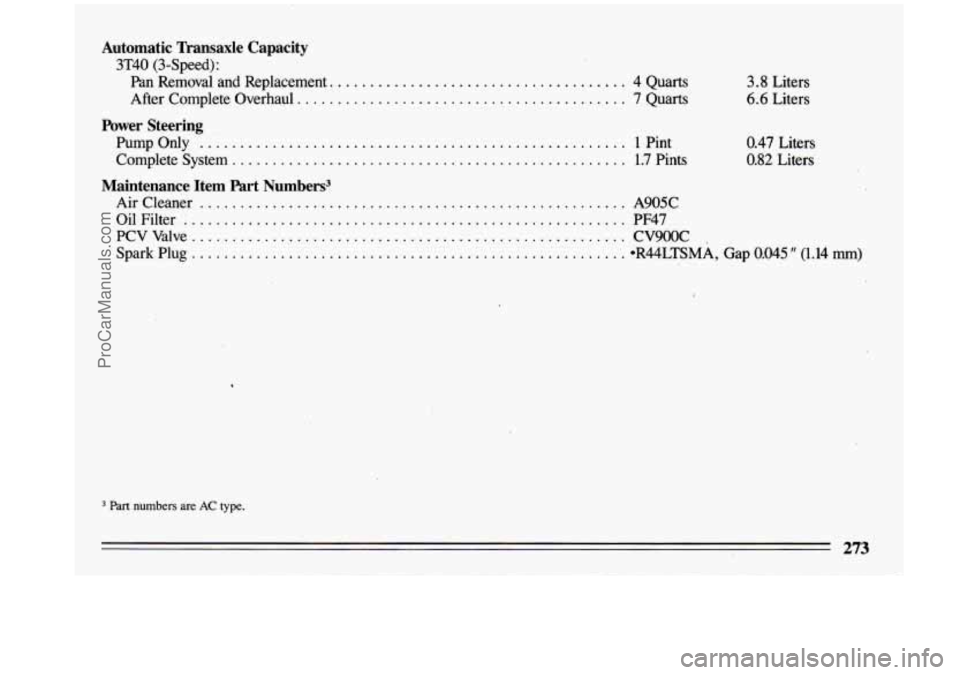
Automatic Transaxle Capacity
3T40 (3-Speed): Pan Removal and Replacement.
.................................... 4 Quarts
After Complete Overhaul.
........................................ 7 Quarts
Power Steering
PumpOnly ..................................................... 1Pint
Complete System
................................................. 1.7 Pints 3.8 Liters
6.6 Liters
0.47 Liters
0.82 Liters
Maintenance Item Part Numbers3
Aircleaner ..................................................... A905C
OilFilter
;...................................................... PF47
PCVValve
...................................................... CV9OOC .
Spark Plug ...................................................... *R44LTSMA, Gap 0.045 " (1.14 mm)
Part numbers are AC type.
273
ProCarManuals.com
Page 292 of 324
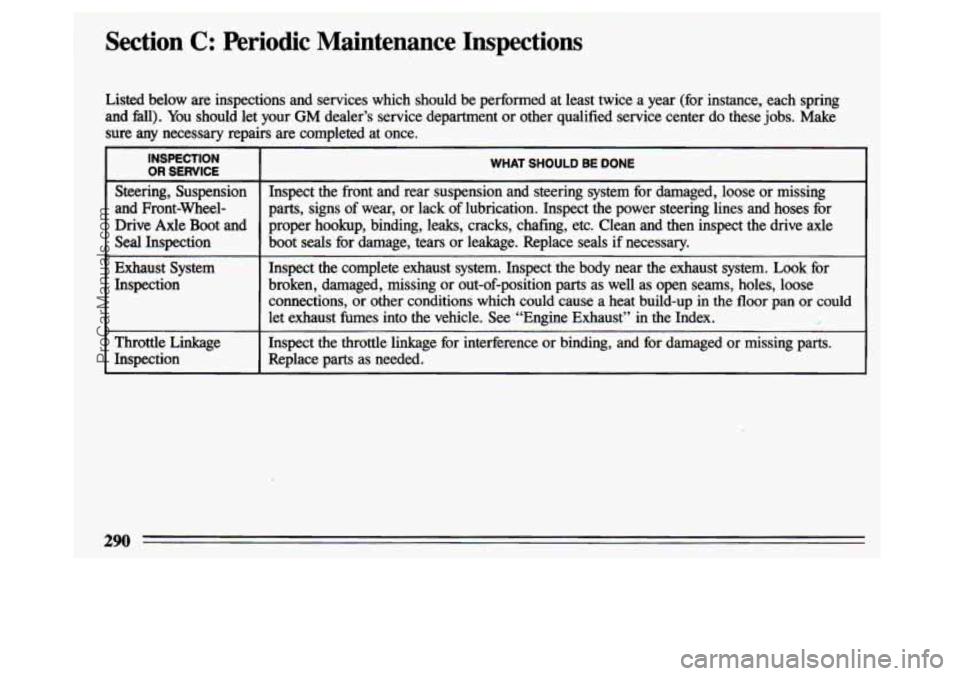
Section C: Periodic Maintenance Inspections
Listed below are inspections and services which should be performed at least\
twice a year (for instance, each spring
and M1). You should let your
GM dealer’s service department or other qualified service center do these jobs. Make
sure any necessary repairs are completed at once.
INSPECTION
OR SERVICE
Steering, Suspension
and Front-Wheel- Drive Axle Boot and
Seal Inspection
Exhaust System
Inspection
~~~~ ~~
Throttle Linkage
Inspection
WHAT SHOULD BE DONE
Inspect the front and rear suspension and steering system for \
damaged, loose or missing
parts, signs of wear, or lack
of lubrication. Inspect the power steering lines and hoses for
proper hookup, binding, leaks, cracks, chafing, etc. Clean and \
then inspect the drive axle
boot
seals for damage, tears or leakage. Replace seals if necessary.
Inspect the complete exhaust system. Inspect the body near the \
exhaust system. Look for
broken, damaged, missing or out-of-position parts as well as op\
en seams, holes, loose
connections, or other conditions which could cause a heat build\
-up in the
floor pan or could
let exhaust fumes into the vehicle. See “Engine Exhaust”
in the Index.
Inspect the throttle linkage for interference or binding, and f\
or damaged or missing parts.
Replace parts as needed.
290
ProCarManuals.com